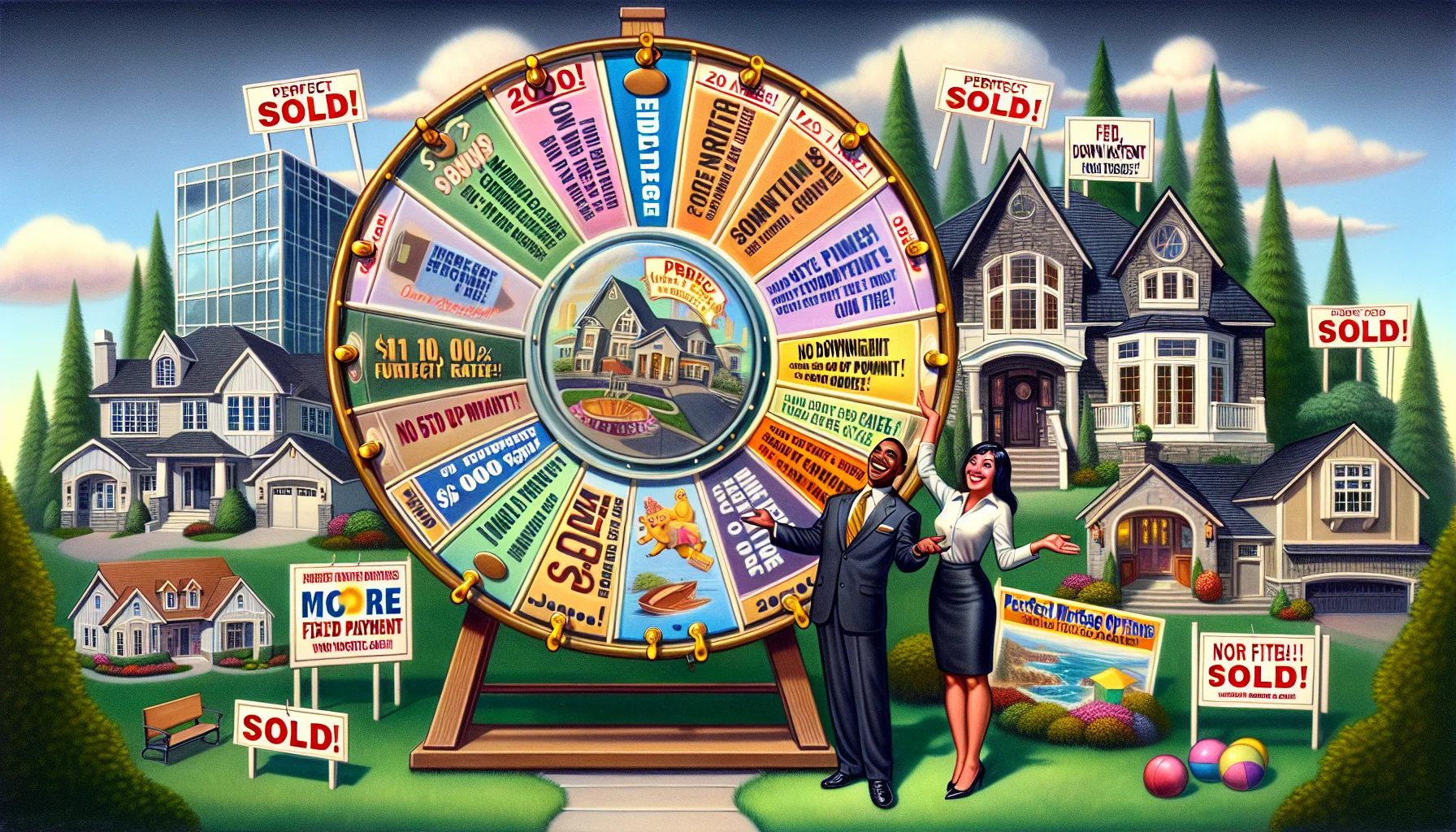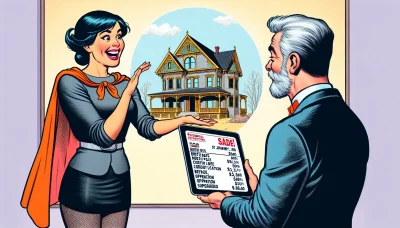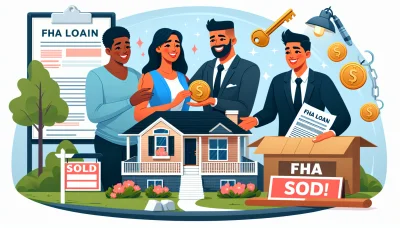Mortgage options Quiz
Test Your Knowledge
Question of
Understanding Mortgage Types
Fixed-Rate Mortgages
Embarking on the journey of homeownership often begins with choosing a mortgage that aligns with your financial goals. Fixed-rate mortgages stand as a bastion of predictability in an otherwise fluctuating market. Locking in an interest rate means your principal and interest payments remain unchanged throughout the life of the loan.
The allure of fixed-rate mortgages lies in their simplicity and protection against rising rates. Homebuyers can budget with confidence, knowing their housing expenses are set in stone. This type of mortgage is a particularly appealing choice for those planning to stay in their home long-term.
Benefits of a Stable Interest Rate
A stable interest rate shields borrowers from the economic turbulence that can affect variable-rate loans. Stability equates to easier financial planning, as monthly payments are fixed and immune to the whims of the market. It's a financially conservative choice that pays dividends in peace of mind.
With a consistent rate, you're insulated from sudden spikes in interest costs, which can be crucial during periods of inflation. This stability offers not just budgetary ease but also allows for more predictable long-term financial strategies.
Comparing Terms: 15-Year vs. 30-Year Mortgages
The term length of a mortgage dramatically impacts overall interest paid and monthly payment size. A 15-year term comes with higher monthly payments but results in less interest over time, while a 30-year term eases monthly budget strain at the cost of more interest paid throughout the loan's lifecycle.
Selecting between a 15-year and 30-year fixed-rate mortgage hinges on your financial capacity and long-term goals. The shorter term accelerates equity building and leads to quicker loan payoff, whereas the longer term offers more breathing room in your monthly finances.
Adjustable-Rate Mortgages (ARMs)
For those willing to dance with uncertainty for potential rewards, adjustable-rate mortgages (ARMs) offer an initial lower interest rate that adjusts over time. This introductory period can translate into significant initial savings, making it an enticing option for certain borrowers.
ARMs are especially attractive if you plan to sell or refinance before the rate adjusts, or if you expect an income increase that would absorb higher future payments. They're a gamble on future market conditions but can be strategically advantageous.
How ARMs Adjust Over Time
The mechanics of ARMs are guided by indexes and margins that dictate how and when the rates adjust. After the initial fixed period ends, rates change annually based on prevailing market trends. Understanding these terms is crucial for managing future financial risk.
- Initial Rate: Enjoy lower payments at the start.
- Adjustment Period: Know when changes occur.
- Index: Understand what influences rate changes.
- Margin: Factor this into the eventual rate calculation.
- Rate Caps: These limit how much your rate can increase.
- Floor Rate: The minimum rate you'll pay despite index dips.
- Ceiling Rate: The maximum possible rate you could face.
Evaluating Caps and Ceilings
Caps and ceilings are critical safety features within ARMs, protecting borrowers from extreme fluctuations in interest rates. Periodic caps limit the amount a rate can increase from one adjustment period to the next, while lifetime caps define the maximum rate increase over the life of the loan.
Evaluating these safeguards is paramount when considering an ARM; they are your defense against volatile economic shifts. They ensure that even if market rates soar, your mortgage will not exceed predetermined thresholdscrucial for long-term financial security.
Government-Backed Mortgage Programs
FHA Loans
FHA loans are a lifeline for first-time homebuyers and those with lower credit scores. Backed by the Federal Housing Administration, they allow purchases with a lower down payment. This opens the door wider to homeownership, where traditional financing might be out of reach.
Refinancing an existing mortgage is also an option with FHA loans. Homeowners can tap into the benefits of better interest rates or reduced monthly payments, even if their financial situation has changed since the original purchase.
Qualifying for an FHA Loan
To qualify for an FHA loan, applicants need a minimum credit score of 580 to make a 3.5% down payment. Those with scores between 500 and 579 must put down 10%. Plus, your debt-to-income ratio is crucialit must show that you can handle your current debts plus your new mortgage.
There's no need to be overwhelmed by paperwork. Yes, there's documentation neededproof of income, savings, and employment historybut lenders are there to guide you through the process. They're adept at navigating these waters and can help secure your FHA loan approval.
FHA Loan Limits and Requirements
FHA loan limits vary by region and are recalibrated yearly. This ensures they reflect home prices in each area. In 2022, for example, the limit for a single-family home ranged from $420,680 to $970,800 in high-cost areas.
Requirements extend beyond financial boundaries; property standards are also set high. Homes financed under FHA must meet safety, security, and structural integrity criteria because these loans are about providing stable housing options.
VA Loans
VA loans are a powerful benefit exclusive to veterans and service members, offering zero-down-payment options and no private mortgage insurance (PMI). These perks make homeownership more accessible and affordable for those who have served our country.
The VA loan program is built on the honor systemyou've earned this benefit through your service. As such, lenders often view VA loans as less risky because of the government guarantee. This translates into better terms for borrowers.
Advantages for Veterans and Service Members
The advantages of VA loans are substantialno requirements for a down payment or PMI can save thousands over the life of the loan. Competitive interest rates mean more manageable monthly payments and long-term savings.
- No Down Payment: The hallmark of VA loans is that 100% financing is availableyou don't need to save up for a large down payment.
- No PMI: Unlike conventional loans where PMI is required if you put down less than 20%, VA loans do not have this requirement.
- Limited Closing Costs: The VA limits certain closing costs lenders can chargemeaning more savings for you at closing time.
- VA Assistance: If you struggle with payments, the VA offers assistance to help avoid foreclosure.
Understanding the VA Funding Fee
The VA funding fee is a one-time payment that helps keep the loan program running for future generations of service members. It varies based on several factors such as your military service type, down payment amount, and whether it's your first VA loan use.
In many cases, this fee can be rolled into your loan amount to ease upfront costs. Moreover, some individuals may be exempt from this fee altogetherlike those receiving VA disability compensation or eligible surviving spouses.
Mortgage Qualification Criteria
Credit Score Requirements
When you're diving into the world of home ownership, your credit score is like the golden key to unlocking mortgage options. Lenders use this little three-digit number to gauge your financial reliability. Generally, a score of 620 is considered the baseline for securing a conventional loan, but if you're eyeing those top-tier rates, aim for a 740 or above!
Don't fret if your score isn't sky-high! Government-backed loans, like FHA or VA loans, might still be within reach as they often have more lenient credit requirements. This means even with a score in the 500s, that dream home may not be just a dream after all.
Improving Your Credit Score for a Mortgage
Boosting your credit score feels like prepping for a financial marathonit's all about endurance and smart moves. Start by checking your credit report for errors and disputing any inaccuracies. Timely bill payments are crucial; they account for a hefty portion of your score. Also, keep those credit card balances low; high utilization can be a red flag to lenders.
Avoid taking on new debt or closing old accounts before applying for a mortgage. Such actions can cause temporary dips in your score. Remember, consistency is keymaintain good financial habits and watch your score climb!
How Credit Scores Affect Interest Rates
Your credit score doesn't just affect whether you get approvedit's also pivotal in determining the interest rates you'll pay. Think of it as the price tag on borrowing money; higher scores often unlock lower rates. It's simple: better credit equals more savings over the life of your loan.
A lower rate can mean saving thousands over the years. So it paysliterallyto improve your credit score before shopping for that mortgage. Every point increase in your credit score can edge down that interest rate, making your monthly payments more manageable.
Income and Employment Verification
Lenders want to know you've got the dough to cover those monthly payments. They'll delve into your income history like detectives to ensure stability and consistency. Be prepared to provide tax returns, pay stubs, and W-2s or 1099s. If you're self-employed, brace yourself for extra scrutinyyou'll need to prove that your business income is steady and reliable.
Employment verification isn't just about confirming where you work; it's about painting a picture of job stability and career trajectory. Lenders love seeing two years or more with the same employer or in the same industryit suggests you're less likely to default due to sudden income changes.
Documenting Your Income for Lenders
- Gather recent pay stubs showing year-to-date earnings.
- Copies of your last two years' tax returns are non-negotiablehave them ready.
- If you receive bonuses or commissions, present documentation proving these are regular parts of your income.
- For those who are self-employed: profit-and-loss statements and bank statements may also be required to demonstrate income stability.
- Keep records of any additional income sources such as rental properties or investmentsthey count too!
- Rely on alimony or child support? Legal documents validating these payments will be necessary.
The Role of Employment Stability in Mortgage Approval
Lenders aren't just handing out mortgagesthey're investing in you. That's why they put so much emphasis on employment stability; it's indicative of financial reliability. A long-term position with steady growth suggests that you're less likely to face an employment hiccup that could impact your ability to pay the mortgage.
If you've recently switched jobs, don't panic! It's not an automatic disqualifier. Just be ready to explain any career moves and demonstrate how it benefits your financial situationthink promotions or industry advancements.
Down Payment Strategies
Saving for a Down Payment
The journey to homeownership begins with saving for a down payment, and it's crucial to set realistic goals. Start by determining how much you can afford and then calculate the down payment required. Typically, 20% of the home's purchase price is ideal, but lower percentages are often possible.
Automating your savings can streamline the process. Set up a direct deposit from your paycheck into a dedicated savings account. This out-of-sight approach helps resist the temptation to spend what you should be saving.
Cutting back on non-essential expenses can also accelerate your saving timeline. Review your monthly spending and identify areas where you can make cuts or find cheaper alternatives, funneling those savings directly into your down payment fund.
Budgeting Tips for Future Homeowners
- Track Your Spending: Use budgeting apps or spreadsheets to monitor your financial habits.
- Reduce High-Interest Debt: Pay off credit cards and loans with high interest to free up more money for saving.
- Increase Income: Consider side gigs or overtime work to boost your down payment fund.
- Cut Unnecessary Subscriptions: Eliminate recurring charges for services you rarely use.
- Save Windfalls: Dedicate any unexpected financial gains, like tax refunds, directly to your down payment savings.
Down Payment Assistance Programs
Investigate local and federal down payment assistance programs as they can provide significant support. First-time homebuyer programs often offer grants or low-interest loans to help cover down payment costs. Eligibility typically depends on income level and the purchase location of the property.
Dedicated research into available assistance programs in your area is essential. Many programs have specific requirements and deadlines that must be met, so staying informed is key to taking advantage of these opportunities.
Low Down Payment Options
A hefty down payment isn't always feasible, but there are loans that require as little as 3-5% down. These options make homeownership more accessible, especially for first-time buyers. However, it's important to understand that a smaller down payment might mean larger monthly mortgage payments over time.
Federal Housing Administration (FHA) loans are a popular choice for those seeking low down payment options. They allow down payments as low as 3.5% and are more lenient on credit scores compared to conventional loans.
Exploring Loans with 3-5% Down Payments
Beyond FHA loans, other programs like Freddie Mac's Home Possible and Fannie Mae's HomeReady mortgage cater to low- to moderate-income borrowers with down payments as low as 3%. These programs often come with reduced private mortgage insurance (PMI) costs and lower interest rates.
Veterans Affairs (VA) loans and USDA loans offer no-down-payment options for eligible veterans, active-duty military personnel, and rural homebuyers respectively. These programs aim to make homeownership more attainable for underserved groups.
The Impact of Down Payment on Mortgage Insurance
A smaller down payment typically means you'll have to pay for mortgage insurance, which protects the lender in case you default on the loan. PMI is required for conventional loans with less than a 20% down payment but can be removed once equity reaches a certain level.
The cost of PMI varies based on the size of the down payment and loan but expect it to add anywhere from 0.5% to 1% of the entire loan amount annually. It's essential to factor this cost into your budget when considering lower down payment options.
Interest Rates and the Economy
Interest rates are the lifeblood of the financial world, acting as a bridge between savers and borrowers. They are crucial in determining how much you'll pay to borrow money or earn on savings. Interest rates are influenced by a variety of factors, including economic growth, inflation, and monetary policy.
The economy thrives when interest rates are balancednot too high to discourage borrowing and spending, nor too low to cause excessive inflation. The equilibrium is delicate and constantly shifts with global and domestic economic changes. Understanding these dynamics is essential for investors, homebuyers, and businesses alike.
How Market Conditions Affect Rates
Market conditions swing like a pendulum, affecting interest rates with each tick. During an economic upswing, rates often rise to keep inflation in check. Conversely, during downturns, rates may fall to encourage borrowing and stimulate spending. Being aware of these trends can help you predict rate changes.
Inflation is a key playerit erodes purchasing power and prompts central banks to hike interest rates. Economic growth also plays its part; robust growth can lead to higher rates as demand for credit increases. Monitor these indicators to make informed decisions about your finances.
The Federal Reserve's Role in Mortgage Rates
The Federal Reserve is the conductor of the U.S. monetary symphony, setting the tempo with its federal funds rate. While not directly setting mortgage rates, its policies ripple through the economy influencing them significantly. When the Fed raises its rate, lenders often follow suit, raising mortgage rates.
The Fed steps in to cool or heat the economy as neededincreasing rates to temper inflation or decreasing them to spur growth. Their actions are critical for homebuyers to monitor as they can impact monthly mortgage payments and overall affordability of home ownership.
Economic Indicators to Watch as a Homebuyer
As a homebuyer, certain economic indicators can be your North Star guiding you through the murky waters of mortgage rates. Keep an eye on employment reports, GDP growth data, and consumer price index readingsthey're harbingers of where interest rates might head next.
Additionally, watch out for housing market trends such as inventory levels and new construction starts. These figures can give insight into future interest rate movements and help you time your home purchase effectively.
Locking in Your Interest Rate
A rate lock is like an insurance policy against rising interest ratesa guarantee from a lender that you'll have a certain interest rate for a specified period while you finalize your home purchase. It's a strategic move that can save you money if done at the right time.
However, locking in too early could mean missing out on potential rate drops. It's all about timing; working with financial advisors or closely watching market trends can aid in making this critical decision.
When to Lock in a Rate
- Assess Market Trends: Keep abreast of current market conditions and expert forecasts before deciding to lock in your rate.
- Consider Your Timeline: If closing on your house is imminent, locking in your rate can protect you from sudden increases.
- Evaluate Loan Terms: Ensure that the loan terms offered with the rate lock align with your financial goals and capabilities.
- Risk Tolerance: If potential rate fluctuations make you uneasy, locking in may provide peace of mind despite possible missed opportunities for lower rates.
- Lender's Policy: Understand your lender's specific rate lock rules including fees, extension options, and what happens if the lock expires before closing.
Refinancing Your Mortgage
When to Consider Refinancing
Refinancing your mortgage can be a game-changer for your finances! It's the perfect move when interest rates drop, allowing you to lower monthly payments and save a fortune on interest. But it's not just about rates; refinancing can also help you change loan terms, consolidate debt, or fund major expenses. Timing is everythingmake sure the benefits outweigh the costs before you leap!
Don't overlook the break-even pointthe moment when savings surpass costs. It's a pivotal factor in deciding whether refinancing is worth it. Consider closing costs too; they're unavoidable but can be rolled into the loan if you're short on cash. Think long-termwill you stay in your home long enough to recoup these expenses? If so, refinancing could be your financial high-five!
Assessing Break-Even Points and Closing Costs
Crunch those numbers before you refinance! The break-even point is your financial compassit guides you to when your savings from a new loan will cover the initial costs. Factor in fees like application, origination, and appraisal charges. Ignore this, and you might as well throw money out the window! A clear understanding here means smarter decisions for your wallet.
Closing costs are no small detailthey can run between 2% to 5% of your loan amount. Get an estimate early and negotiate where possible. Sometimes lenders offer 'no-closing-cost' loans but compensate by charging a higher interest rate. Be savvy: compare offers, read the fine print, and choose what's best for your financial future.
Long-Term vs. Short-Term Financial Goals
Are you a financial sprinter or marathoner? Short-term goal setters might refinance for lower monthly payments, freeing up cash for other expenses or investments. If you're playing the long game, refinancing might mean switching from an adjustable-rate to a fixed-rate loan for stable payments over time or shortening the loan term to build equity faster and save big on interest.
Your financial horizon is key when considering refinancing options. A shorter loan term typically comes with higher monthly payments but less total interest over the life of the loana win for long-term savers. On the flip side, extending your loan term can reduce monthly payments but cost more in interest over timegreat for immediate budget relief.
Types of Refinance Loans
Dive into the world of refinance loansthey come in all shapes and sizes! The right one depends on your goals: cutting down monthly payments, tapping into home equity, or simplifying finances with a government-backed program. Each type offers unique benefits; understanding them means making choices that align with your financial aspirations.
Lenders love varietythey'll throw options like rate-and-term refinance or cash-out refinance at you. Rate-and-term is all about snagging better interest rates or changing how long you'll pay off that mortgage; it's a straight swap of terms without touching your home equity. Cash-out? That's when you borrow more than you owe and pocket the differencehello renovation money!
Cash-Out Refinance Explained
A cash-out refinance is like hitting two birds with one stoneyou get a fresh mortgage with new terms and walk away with extra cash in hand! It's ideal when home values soar; tap into that increased equity to consolidate debt or fund that dream kitchen makeover. Just remember: it increases your loan amount, so consider it carefully against your financial plan.
This strategy isn't free moneyit comes with responsibility! You're borrowing against your home's value, so think about how it impacts your overall debt load and whether it fits into your long-term financial goals. The extra funds can be life-changing if used wiselyfor investments that grow in value or paying down high-interest debts.
Streamline Refinancing for Government Loans
If paperwork gives you nightmares, streamline refinancing is like a dream come true! Designed for government-backed loans like FHA and VA loans, this process simplifies refinancing by waiving extensive documentation requirements. No income verification? No problem! Lower credit standards? You got it! This means less stress and faster closing times.
- FHA Streamline Refinance: No appraisal needed; focus on lowering monthly payments and interest rates.
- VA Streamline Refinance (IRRRL): Veterans can switch from adjustable to fixed rates hassle-free with no out-of-pocket costs.
- USDA Streamline Refinance: For rural homeowners looking to reduce their rates with minimal fuss.
Preparing for the Closing Process
Understanding Closing Costs
Closing costs can be a complex part of the home-buying process, but they are crucial to understand. These are the fees and expenses you pay to finalize your mortgage beyond the property price. It's typically between 2% and 5% of the loan amount, covering everything from appraisal fees to title insurance.
Being well-informed about what closing costs entail can significantly influence your budgeting decisions. It's not just about saving for your down payment; you also need to account for these additional expenses to avoid any last-minute financial surprises.
Itemized Closing Costs and Fees
An itemized list of closing costs will include lender-specific fees, third-party charges, and pre-paid items such as escrow funds. Common fees include loan origination fees, credit report charges, appraisal fees, and title insurance premiums. A clear understanding of these terms is essential for a smooth closing process.
Your lender is required to provide a Loan Estimate that outlines these expected costs within three days of your loan application. Scrutinizing this document can help you prepare for what's ahead and spot any discrepancies early on.
Strategies to Reduce Closing Expenses
You can employ several strategies to reduce your closing costs. One approach is to negotiate with the seller to pay some of the expenses as part of the purchase agreement. Additionally, shopping around for certain services like home inspections or title searches can save money.
- Compare lender fees and service costs from different providers.
- Ask lenders for a 'no-closing-cost' mortgage option, which might involve a higher interest rate but lower upfront fees.
- Inquire about discounts or loyalty programs that may apply to you.
- Consider closing at the end of the month to reduce the amount of prepaid daily interest charges.
Final Steps Before Closing Day
The days leading up to closing are critical in ensuring that everything goes as smoothly as possible. This is when you finalize all agreements and confirm that both parties have met their obligations. It's also a time for reviewing documents carefully so there are no misunderstandings about the terms of sale or ownership transfer.
It's essential to stay in close contact with your real estate agent and lender during this period. They will guide you through what needs to be done and help keep track of any last-minute details that must be addressed before you officially become a homeowner.
The Importance of the Final Walkthrough
The final walkthrough is your last chance to inspect the property before taking ownership. This typically occurs 24 hours before closing day. You should ensure that all agreed-upon repairs have been made, fixtures remain as per contract, and the house is in move-in condition.
If any issues arise during this walkthrough, it's crucial to address them immediately with your real estate agent. The resolution might involve delaying closing or negotiating compensation if problems cannot be fixed promptly.
Reviewing and Understanding Your Closing Disclosure
The Closing Disclosure is a five-page document that gives you final details about your mortgage loan. It includes loan terms, projected monthly payments, and how much you will pay in fees and other costs to get your mortgage (closing costs).
You should receive your Closing Disclosure at least three business days before closing so that you have sufficient time to review it. Compare it with your Loan Estimate closely; discrepancies could indicate errors or changes in terms that need clarification before signing on the dotted line.












